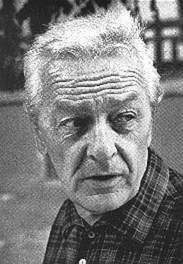KERÉNYI, Jenő
(1908, Budapest - 1975, Budapest)


Sculptor. After the School of Industrial Design, he attended the Art School from 1931 to 1937 where he was a pupil of Jenő Bory, and later his assistant. As a student of the Art School, he won the Municipal Scholarship, then a scholarship to Rome in 1937 where he stayed for a year. He was particularly influenced by Rodin, Bourdelle, Maillol and Etruscan sculpture.
His works were first exhibited in 1938. On his first private commissions, he modelled smaller statues and tombs. The nudes of that time reflected restlessness and his statuettes a security of structure ("Dreamer" 1938, "Leaving Work" 1938, "Laundress" 1939, "Woman Undressing" 1940, and "Combing" 1942). He received his first state commission in 1942: the memorial was erected in Léva in 1943. He modelled a memorial of partisans for Sátoraljaújhely in 1946, one of the first open-air sculptures in Hungary after 1945. "Ostapenkow Memorial" (1951) and "Marchers" (1954) are remarkable works of the 1950s. "Dancers", a statue modelled together with József Somogyi, was awarded the Grand Prix at the World Exhibition in Brussels in 1958. He contributed with his works from the 60s to the revival of arts in Hungary in the mid 60s, e.g. "Legend of Tihany" 1963, "Playing the Flute" 1965, figures of the Csontváry tomb in Kerepesi Cemetery, "Fountain" in Győr, the figure of Genius of a Memorial in Miskolc, "Falconer" 1970, "The Rape of Europe" 1971, "Golgota" 1972, "Moses" 1973, and "Prophet" 1973.
His small statuettes were exhibited in Hungary and abroad. He was awarded the First Prize at the exhibition in Suzarra in 1950. Several of his works were exhibited Venice in 1960. Many of his works are in the collection of the Hungarian National Gallery and in the Kerényi Museum in Szentendre.
